Unit 4 – Our Fisheries
Our Fisheries
Contents
Introduction
History and Overview of The Magnuson-Stevens Fishery Conservation and Management Act (MSA) 16 USC Ch. 38, and the Sustainable Fisheries Act (SFA)
The Rise of Best Available Science, and the Role of Nonprofit Organizations
Introduction
Prior to 1976, fisheries management almost exclusively performed by the 35 coastal states; now the states manage cooperatively with federal government.
The Magnuson Stevens Fishery Conservation and Management Act of 1976 (or MSA, or Fisheries Conservation Management Act FCMA, as amended 2006) covers all commercial and recreational fishing beyond state waters (three nautical miles offshore). Highly migratory species were added in 1990. Over the past forty years, the MSA has adapted to the times, conservation methodology, and developments in marine science and technology. In many respects the MSA is a successful piece of legislation, which will continue to grow and adapt.
History and Overview of The Magnuson-Stevens Fishery Conservation and Management Act (MSA) 16 USC Ch. 38, and the Sustainable Fisheries Act (SFA)
Findings, Purpose and Policy (16 USC § 1801; excerpts only)
a) FINDINGS The Congress finds and declares the following:
(1) The fish off the coasts of the United States, the highly migratory species of the high seas, the species which dwell on or in the Continental Shelf appertaining to the United States, and the anadromous species which spawn in United States rivers or estuaries, constitute valuable and renewable natural resources. These fishery resources contribute to the food supply, economy, and health of the Nation and provide recreational opportunities.
(2) Certain stocks of fish have declined to the point where their survival is threatened, and other stocks of fish have been so substantially reduced in number that they could become similarly threatened as a consequence of (A) increased fishing pressure, (B) the inadequacy of fishery resource conservation and management practices and controls, or (C) direct and indirect habitat losses which have resulted in a diminished capacity to support existing fishing levels.
(3) Commercial and recreational fishing constitutes a major source of employment and contributes significantly to the economy of the Nation. Many coastal areas are dependent upon fishing and related activities, and their economies have been badly damaged by the overfishing of fishery resources at an ever-increasing rate over the past decade. The activities of massive foreign fishing fleets in waters adjacent to such coastal areas have contributed to such damage, interfered with domestic fishing efforts, and caused destruction of the fishing gear of United States fishermen.
(4) International fishery agreements have not been effective in preventing or terminating the overfishing of these valuable fishery resources. There is danger that irreversible effects from overfishing will take place before an effective international agreement on fishery management jurisdiction can be negotiated, signed, ratified, and implemented.
(5) Fishery resources are finite but renewable. If placed under sound management before overfishing has caused irreversible effects, the fisheries can be conserved and maintained so as to provide optimum yields on a continuing basis.
(6) A national program for the conservation and management of the fishery resources of the United States is necessary to prevent overfishing, to rebuild overfished stocks, to insure conservation, to facilitate long-term protection of essential fish habitats, and to realize the full potential of the Nation’s fishery resources. ……
(b) PURPOSES It is therefore declared to be the purposes of the Congress in this chapter—
(1) to take immediate action to conserve and manage the fishery resources found off the coasts of the United States, and the anadromous species and Continental Shelf fishery resources of the United States, by exercising (A) sovereign rights for the purposes of exploring, exploiting, conserving, and managing all fish, within the exclusive economic zone established by Presidential Proclamation 5030, dated March 10, 1983, and (B) exclusive fishery management authority beyond the exclusive economic zone over such
anadromous species and Continental Shelf fishery resources; …
(c) POLICY It is further declared to be the policy of the Congress in this chapter—
(1) to maintain without change the existing territorial or other ocean jurisdiction of the United States for all purposes other than the conservation and management of fishery resources, as provided for in this chapter;
(2) to authorize no impediment to, or interference with, recognized legitimate uses of the high seas, except as necessary for the conservation and management of fishery resources, as provided for in this chapter;
(3) to assure that the national fishery conservation and management program utilizes, and is based upon, the best scientific information available; involves, and is responsive to the needs of, interested and affected States and citizens; considers efficiency; draws upon Federal, State, and academic capabilities in carrying out research, administration, management, and enforcement; considers the effects of fishing on immature fish and encourages development of practical measures that minimize bycatch and avoid unnecessary waste of fish; and is workable and effective; …(end of excerpt)
(law.cornell.edu/uscode/text/16/1801)
1976-1996

Under MSA, the eight US regional fisheries management councils determine the annual allowable catch for each fishery (Maximum Sustained Yield or MSY) and develop a Fishery Management Plan (FMP). Subsequently authors of the FMP determine Optimum Sustained Yield (OSY). OSY = MSY as modified by any relevant social, economic, or ecological factor, and must provide the “greatest overall benefit to the Nation, with particular reference to food production and recreational opportunities.”
Before MSA, foreign fleets could fish up to 12 nm offshore. In accordance with international law since 1983, Coastal States (in this context, we mean nations) have sovereign rights out to the limits of their Exclusive Economic Zones (200 nm) to explore, exploit, and conserve living and nonliving resources. These rights cover every aspect of marine environmental management, including transport, military, pollution, research, and fisheries management.
During 1976-1996, the eight US Regional Fishery Management Councils had broad discretion to meet the short-term needs of the fishing industry; the goal in this early period was Americanization due to increased pressure from foreign fleets. In keeping with the International Law of the Sea, in 1983 Reagan Proclaimed 200 nm EEZ for the United States.
By 1996, US fisheries had become depleted, and the American public became angry. In response, Congress enacted the 1996 Sustainable Fisheries Act (SFA, Public Law PL 104-294), which substantially revised FCMA to refocus efforts toward goals of conservation and ecosystem protection. The Sustainable Fisheries Act requires the eight regional fisheries management councils to make conservation (i.e. rebuilding of stocks) the nation’s the top priority.
It is important to note that fisheries conservation and ecosystem protection as a statutory mandate marks a significant departure from business as usual. Over the short duration of two decades, the post World War II period of scaled-up fishing (driven by protectionism and population-driven consumption) was transformed by lower yields and the practical need to regulate and conserve stocks. It was a national priority to put MSA in place in 1976, before the United Nations Convention on the Law of the Sea (Unit 6) was finalized by nations (including the US) in 1983, establishing the 200 nm EEZ as international customary law.
1996-2006
During the period following 1996, US fisheries management underwent a remarkable, if gradual, statutory (r)evolution to an enforceable conservation emphasis, with accountability and standards built in. The new management paradigm was made possible by technical and scientific advances in ocean and fisheries data availability and sophisticated research methods.
In 1996, Congress revised the MSA with the Sustainable Fisheries Act. The revision incorporated important new definitions, including “overfishing,” a set of ten enforceable National Standards, and a new mandate balancing industry with conservation requirements. Litigation, such as NRDC v Daley, 209 F.3d 747 (DC Cir 2000, discussed later in this Unit) clarified interpretations within the new requirement. The changes introduced in the Sustainable Fisheries Act also required greater management accountability (16 USC § 1854(e)(1)) via mandatory annual reporting to Congress by National Marine Fisheries Service (NMFS, NOAA Fisheries; recent reports are available at nmfs.noaa.gov) (inactive link as of 05/19/2021).
Under the new definitions, overfished means: existing below a prescribed biomass threshold. In a state of being overfished means: Being harvested at a rate above a prescribed fishing mortality threshold (16 USC § 1802(34)).
The term “optimum” … means the amount of fish which—
(A) will provide the greatest overall benefit to the Nation, particularly with respect to food production and recreational opportunities, taking into account the protection of marine ecosystems;
(B) is prescribed on the basis of the maximum sustainable yield from the fishery, as reduced by any relevant social, economic, or ecological factor; and
(C) in the case of an overfished fishery, provides for rebuilding to a level consistent with producing the maximum sustainable yield in such fishery.
MSA National Standards 1 and 2
The enforceable Ten US National Standards (16 USC § 1651; regulations at 50 CFR Chap. VI, Part 600, Subpart D, §600.305) state the following.
Any fishery management plan … shall be consistent with the following national standards:
1) … measures shall prevent overfishing while achieving, on a continuing basis, the optimum yield from each fishery for the US fishing industry.
(2) … measures shall be based upon the best scientific information available.
National Standard Two, requiring actions to be founded on best scientific information available, generates a lot of litigation. Resulting cases provide examples of how the federal courts’ interpretations of statutory terms and phrases can clarify legislative meanings.
Because of precedent (Motor Vehicles Mfrs Assoc., 463 US 29 1983) courts have required plaintiffs to demonstrate that the Councils and Agency relied on no scientific basis whatsoever, a very difficult claim for plaintiffs to prove. Nonetheless, in rare cases plaintiffs have been able to show that a fishery management plan was based purely on political motivations. In cases involving National Standard Two, courts have required that the Councils must expressly provide the scientific rationale they relied on for both conservation and allocation decisions.
MSA National Standards 3 and 4
(3) To the extent practicable, an individual stock of fish shall be managed as a unit throughout its range, and interrelated stocks shall be managed as a unit or in close coordination.
(4) Conservation and management measures shall not discriminate between residents of different States. If it becomes necessary to allocate or assign fishing privileges among various United States fishermen, such allocation shall be
(A) fair and equitable to all such fishermen;
(B) reasonably calculated to promote conservation; and
(C) carried out in such manner that no particular individual, corporation, or other entity acquires an excessive share of such privileges.
Note that 4(C) does not provide details on methods to prevent shares from concentrating in an individual or corporation, nor what to do if shares in a fishery do tend toward or result in a monopolistic entity. However, details to implement fairness could be embedded within individual fisheries’ quota agreements, or other programs for fairly distributing access privileges.
MSA National Standards 5 through 10
(5) Conservation and management measures shall, where practicable, consider efficiency in the utilization of fishery resources; except that no such measure shall have economic allocation as its sole purpose.
(6) Conservation and management measures shall take into account and allow for variations among, and contingencies in, fisheries, fishery resources, and catches.
(7) Conservation and management measures shall, where practicable, minimize costs and avoid unnecessary duplication.
(8) Conservation and management measures shall, consistent with the conservation requirements of this chapter (including the prevention of overfishing and rebuilding of overfished stocks), take into account the importance of fishery resources to fishing communities by utilizing economic and social data that meet the requirements of paragraph (2), in order to
(A) provide for the sustained participation of such communities, and
(B) to the extent practicable, minimize adverse economic impacts on such communities.
(9) Conservation and management measures shall, to the extent practicable,
(A) minimize bycatch and
(B) to the extent bycatch cannot be avoided, minimize the mortality of such bycatch.
(10) Conservation and management measures shall, to the extent practicable, promote the safety of human life at sea.
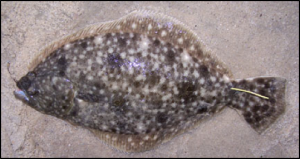
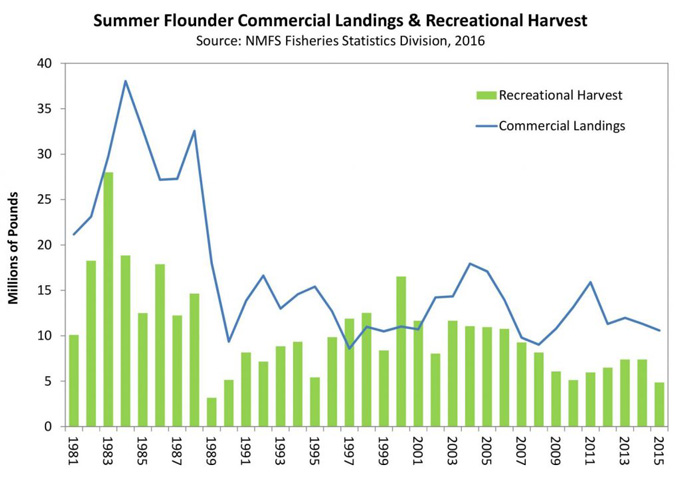
The case NRDC v Daley, 209 F.3d 747 (DC Cir 2000) involved National Standard One, which provides that conservation and management measures shall prevent overfishing while achieving, on a continuing basis, the optimum yield from each fishery.
How much certainty must the Regional Fisheries Management Councils have in order to assert that their proposed actions will end overfishing? In balancing between conservation and short-term cost avoidance, the two goals are not equal; conservation comes first. The Daley court held that in order to comply with the MSA, Councils must have >51% certainty that their proposed actions will end overfishing. In the Daley case NMFS (that reviews and authorizes the eight councils’ decisions) had argued that an 18% chance would be sufficient.
In the Daley case (2000): The court said, “The Government concedes, and we agree, that, under the Fishery Act, the Service (NMFS) must give priority to conservation measures. It is only when two different plans achieve similar conservation measures that the Service takes into consideration adverse economic consequences.”
The 2000 Daley court continued, “Where two alternatives achieve similar conservation goals, the alternative that minimizes the adverse impacts on fishing communities would be preferred.” The regulation that the court was interpreting is 50 CFR Section 600.345(b)(1)
That conservation is a mandatory priority over short-term cost avoidance was confirmed again in NRDC v. NMFS, 421 F.3d 872(9th Circuit 2005). Once again, the NMFS had lost—having claimed that the Pacific Council could establish a 47-year rebuilding period for the dark-blotched rockfish (sebastes crameri).
NMFS had underestimated the severity of the rockfish’s depletion. This triggered statutory language requiring the stock to be rebuilt in “as short a time as possible,” taken to be a 14-year period plus one mean generation time, except for the fact that the dark-blotched rockfish lives 33 years. The standard period by regulation must not exceed 10 years– with exceptions.
In summary, the statutory, regulatory and case law of 1996-2006 displays efforts to further refine the MSA, to prioritize conservation, and to make the law’s requirements to more concrete and transparent. The new mandate for best available science underlying FMPs requires Councils to explain the scientific bases for their decisions. This period also marks the first time MSA provisions included Essential Fish Habitat (EFH) and bycatch.
US Fisheries Management 2006-Present
This section presents a brief overview of the rise of science-based management, the reduction of fishing capacity to reverse overfishing, and the increasing prominence of an interesting new player: the rise of non-governmental organizations (NGOs) in at least two roles: first, as a convener and coordinator of scientific support, and second as legislative initiators and collaborators on fisheries and habitat conservation.
Fisheries management since 2006 represents the further development of the emphasis on conservation. In 2007, the reauthorized MSA was implemented to include further emphasis on scientific management, additional conservation and accountability mandates in all Fishery Management Plans (FMPs), Annual Catch Limits (ACLs), and the introduction of an option known as Limited Access Privilege Programs (LAPPs). The new provisions were required to be implemented in all FMPs by 2010 for all overfished species, and in 2011 in all others. FMPs are based on stock assessments.
Fishery management plans must specify objective and measurable criteria, or reference points, to determine when a stock is subject to overfishing or overfished. A scientific analysis of the abundance and composition of a fish stock and the rate of fishing mortality is called a stock assessment. Typically, a stock assessment undergoes peer review by independent scientists before it is accepted as the best scientific information available.
The councils use information from stock assessments to develop and recommend ACLs and other conservation and management measures. While catch limits are set annually, assessments are often done less frequently. To determine whether catch limits have successfully ended or prevented overfishing, NOAA Fisheries may use either the results of a stock assessment or a comparison of catch to the overfishing limit (OFL). If the catch to OFL comparison is used, an overfishing determination is made annually. If a stock assessment is used, due to timing of the next stock assessment, several years may pass before we are able to determine if catch limits successfully ended overfishing (Stocks Status 2016).
From 2007-on, all Fishery Management Plans (FMPs) required conservation mandates, as well as stated Annual Catch Limits (ACLs) designed to avoid overfishing. Data on the progress of ACLs to meet this goal are detailed annually in the MSA-mandated report to Congress. For 2016, for example, 92 percent of all stocks were successfully kept at or below the ACLs set for them. By law, the regional councils must investigate and take steps to correct management of stocks that exceeded ACLs (Stocks Status 2016).
The required Annual Catch Limits (16 U.S.C. § 1853(a)(15))are devised by each Fishery Management Council’s Scientific and Technical Committee. If the Committee does not recommend an ACL, a Council is still required to set one.
According to NOAA, the 2007 reauthorization required two kinds of Accountability Measures (AMs): in-season measures to prevent exceeding the Annual Catch Limit or ACL, and AMs to address any overage of the ACL. The ACL AMs include identification of operational factors that led to the overage, and a plan to mitigate biological harm to the stock, if any. Accountability with regard to ACLs is described in 16 USC § 1853(a)(15). Accountability with regard to the Annual Catch Limits (ACLs) is covered in 16 USC § 1853(a)(15). ACLs are mandatory limits.
Because of uncertainty, there is always a chance that overfishing could occur. To prevent chronic overfishing, the system of ACLs and Accountability Mandates (AMs) should be re-evaluated and modified if the ACL is exceeded more than once in 4 years.
Councils and NMFS can apply a higher performance standard if a stock is particularly vulnerable to the effects of overfishing. Annual Catch Limits (ACLs) must not exceed the recommendations of each council’s scientific and statistical committee or the peer review process (16 USC § 1852(h)(6)).
Determination of an ACL requires three types of data (fisheries data, biological data, and ecological data) followed by analysis:
Data and Analysis
Data:
- Fisheries Data
- Age, size, sex and weight distributions
- Geographic distributions
- Catch and effort data/history
- Biological Data
- Abundance
- Growth rates
- Where and what the species feeds on
- Age and size at maturity
- Life span
- When, where, and how fish reproduce
- Vulnerability to overfishing
- Ecological Data
- Predator/prey relationships
- Habitat requirements
- Other species of fish that coexist within their “neighborhood”
- Similarities to other, more extensively studied species
Analysis:
Scientists use a variety of information from various sources, including independent research such as National Oceanic and Atmospheric Administration (NOAA) surveys and academic reports; and “fishery dependent” sources such as reported catch data from fishermen’s logbooks, targeted and incidental catch reports from on-board observers, and dealer surveys. This information, combined with analytical methods, such as modeling, helps scientists recommend limits unique to each fish and fishery.
(Source: PEW Fact Sheet; Bringing Back the Fish 2013)
Limited Access Privilege Programs (LAPPs)
Limited Access Privilege Programs (LAPPs) are described in 16 USC § 1853a. LAPPs are an optional, and not mandatory tool (§ 1853a(a)). If a Regional Fishery Management Council elects to develop a LAPP, it must incorporate certain protections outlined in § 1853a.
LAPP Requirements:
Any limited access privilege program to harvest fish submitted by a Council or approved by the Secretary under this section shall—
(A) if established in a fishery that is over- fished or subject to a rebuilding plan, assist in its rebuilding;
(B) if established in a fishery that is determined by the Secretary or the Council to have over-capacity, contribute to reducing capacity;
(C) promote— (i) fishing safety; (ii) fishery conservation and management; and (iii) social and economic benefits (16 USC § 1853a(c)).
Communities are also eligible for LAPPs. To participate, a community must be located in a Council’s area and meet certain criteria. The community must consist of residents who are commercial or recreational fishermen, processors, or fishery-dependent businesses. Finally, the community must develop and submit a Community Sustainability Plan that addresses social and economic development needs. LAPPs and their requirements are covered in 16 USC § 1853a(c)3(A)(i).
The Rise of Best Available Science, and the Role of Nonprofit Organizations
Powerful nonprofit organizations became involved in fisheries conservation and have assumed a leading role in raising public awareness, bridging divides between sectors, and generating independent peer-reviewed reports. In a watershed moment in 2006, the Nature Conservancyand the Environmental Defense Fundpursued a buy-out of permits and vessels in the troubled Pacific groundfish fishery, in exchange for a binding agreement from the Pacific Regional Fishery Management Council to remove particular seafloor areas off central California from bottom trawling as part of the PRFMC Essential Fish Habitat amendment to the groundfish FMP. The final rules designating the EFH and creating the no-trawl zones are available at 71 Fed. Reg. 27408 (May 11, 2006).
At least two important NGO studies and reports from this period are worth noting.
- PEW Charitable Trusts 2013: The Law That’s Saving American Fisheries, The Magnuson-Stevens Fisheries Conservation and Management Act
- NRDC 2013: Bringing Back the Fish
The PEW report includes a list of elements of successful rebuilding programs (PEW)
- Well-defined objectives
- Finite timelines
- Established in an open and transparent process
- Credible, consistent, and transparent scientific monitoring
- Simple and easily understood metrics of status and success
- Predefined rules for triggering corrective management action
- Substantial, measurable reductions in fishing mortality at the onset of the plan
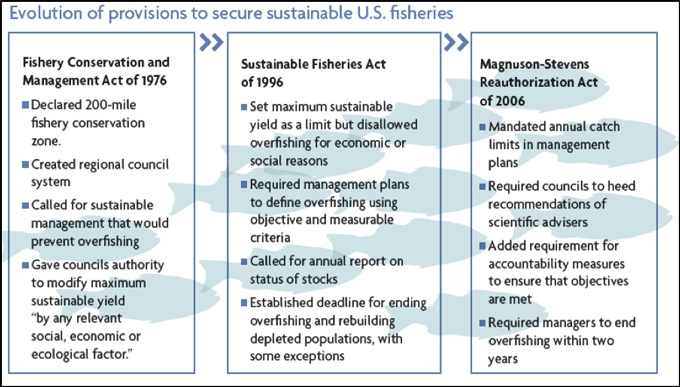
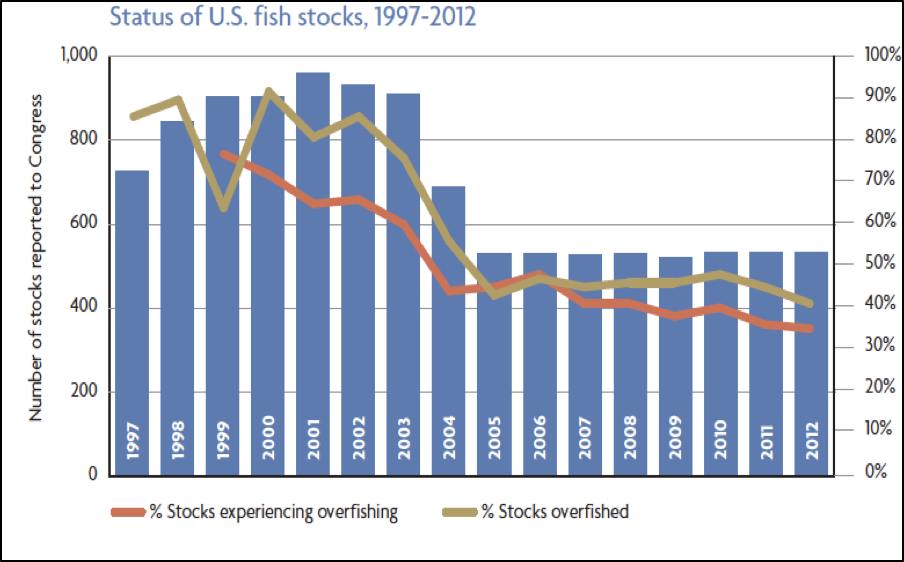
Science-based limits, combined with accountability to ensure that catches are consistent with restrictions, get results. The use of science-based limits is not a new idea; it has long proven effective for managing fisheries and rebuilding populations. Analyses from cases all over the world show that fish populations rebound when excess fishing mortality is reduced. Of 24 depleted stocks worldwide with formal rebuilding plans to reduce excess fishing mortality, all but one recovered.
The 2013 report by NRDC 2013 pointed out the following gaps.
- 30% of stocks have inadequate data
- Important stocks (river herring, shad, menhaden, Atlantic sturgeon) are not federally managed so not subject to rebuilding even though recognized as depleted
- NRDC Gaps seem to focus on inconsistencies and lack of information
- The report points out that unmanaged stocks may have state management plans that fall short of MSA standards (inconsistent management in state and federal waters)
- Internationally managed stocks are subject to less stringent rebuilding requirements (inconsistent management across governance structures)
- “more than 200 international stocks (including more than 50 that NMFS considers major stocks) identified as overfished are designated as having ‘unknown’ or ‘undefined’ overfished status”
The NRDC 2013 report estimates that 21 stocks (or 48% of overfished) are considered rebuilt.
Significant Rebuilding Progress (7 stocks or 16%) means that greater than or equal to 50% of the rebuilding target AND greater or equal to 25% increase since the start of the plan
Limited Rebuilding Progress (8 stocks or 18%) means that greater than or equal to 50% of the rebuilding target OR greater or equal to 25% increase since the start of the plan
Lack of Rebuilding Progress (8 stocks or 18%) means less than 50% of rebuilding target AND Less than 25% increase since the start of the plan
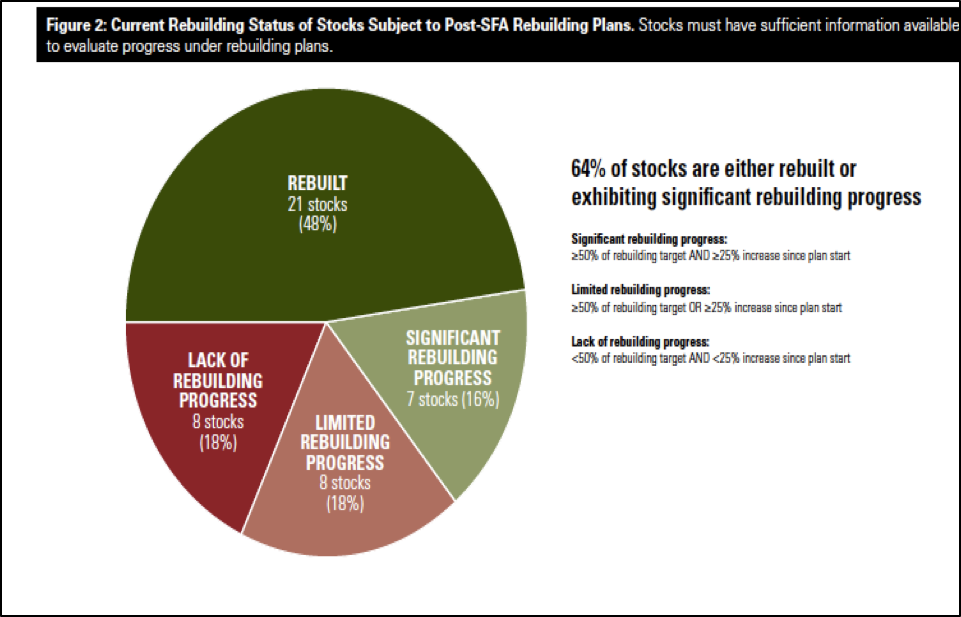
A 2018 NRDC update indicates that 40 federally managed species important to commercial and recreational fishermen are still overfished or at risk. However, the overall recovery shows that the 2007 revisions to MSA are working.

An appendix of Resources at the end of the book contains additional details relevant to fisheries (see resources for unit four).
Unit 5 will discuss regulatory aspects of a wide range of environmental impacts on oceans.
Unit 4 Study Questions
- For some stocks, little or no data exist. Theorize effective policy options for confronting uncertainty in establishing management plans for those stocks.
- What are potential methods of achieving (over time) greater consistency at management scales (state, federal, international)?
- Since 1976 when Congress passed MSA, one of the greatest movements has been toward stakeholder identification, outreach and inclusion. Who are the stakeholders in regard to the nation’s fisheries?

